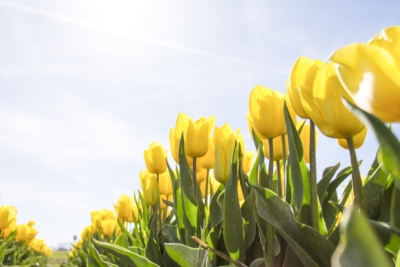
Bulbs are an easy, economical way of producing a vibrant and colorful flower garden and, in New England especially, the sight of their spring or summer blossoms can be a welcome reprieve from a long, cold winter. Gardeners will often plant bulbs in intervals so that they will have continuous blossoms throughout the spring, summer and fall. Even when blossoms have faded at the end of peak seasons, plants grown from bulbs still accentuate the looks of a garden with their showy foliage. Under careful growing conditions, bulbs will continue to blossom year after year.
Common Types of Bulbs
Bulbs are divided into two general categories: fall-planted and spring-planted. The fall-planted category includes tulips, daffodils, crocuses, and hyacinths, which flower in the spring. They should be planted in the fall since root development is stimulated through the dormant winter period. These bulbs must be planted before the first heavy frost, be exposed to full or medium sun and be planted in locations with adequate drainage.
The spring-planted category consists of bulbs that are not meant for winter temperatures and includes cala lilies, begonias and dahlias. These varieties flower in the summer and fall and should be planted in late spring. Most, but not all, summer-blooming bulbs are annuals. The bulbs should be dug up each fall and stored in a cool location until planting time.
Planting Steps
The following outdoor planting steps, with a couple exceptions, apply to both common types of bulbs:
Choose a location – As previously mentioned, sun exposure and drainage are key components when deciding where bulbs should be planted. Look for an area that gets ample sunlight and has good drainage as to prevent rot. Also make sure the area has adequate space, as different species of bulbs have different spacing requirements. With perennial bulbs, it is important that they are in a location where they will remain undisturbed during the cold winter temperatures.
Prepare Beds – Mix fertilizer such as Espoma Blub Tone, bonemeal/wood ashes, or other phosphorous and potassium sources into the soil below the level of the bulbs. Mix in compost to lighten heavy soils and increase nutrients. Peat is acidic – use with caution.
Plant Bulbs – Plant your bulbs pointed side up. Planting depth averages about 3 times the size of the bulb but depth requirements vary according to species. Make sure to check before planting. Another thing to check is spacing requirements for a particular species, or how far apart the bulbs should be in the ground. Topdress the bed with compost.
Mulch Your Bulbs – This step applies primarily to bulbs which will remain in the ground through the winter season. Use 4-6” of leaves, bark, straw, etc. after the ground freezes, especially if the bulbs are planted near your house. Otherwise, basement heat and reflected sunlight can remove insulating snow cover, exposing bulbs to alternately sunny days and freezing nights and damaging their growth tips. Remove mulch as bulbs begin to peak through in the spring and dress the bed with compost.
Pinch Blooms as They Fade – This is to discourage seed production and force the energy of the plant back into the bulb. This is especially important for tulips and hyacinths which would otherwise lose their vigor in 2-3 years.
Do Not Cut the Foliage – As long as it remains green, it produces food for future blooms. Cut leaves only after they yellow.
Pests
The most common pest that affect bulbs are rodents such as chipmunks, squirrels, mice, moles and voles. While chipmunks, squirrels and mice will actually dig up and feed on the bulbs, moles and voles can disturb them with their tunneling in the soil. Some preventions that are effective for mammal pests include planting under a chicken wire barrier, moth balls or flakes, baited live traps and having their natural predators around (cats, owls, hawks).
Insect pests may include mites, aphids, thrips and bulb flies. Signs of insect infestation include leaf discoloration and soft, rotted bulbs. Infestation can be prevented by using insecticidal soap such as Bon-Neem by Bonide on bulbs, plants and flowers, introducing beneficial bugs to your garden such as ladybugs or lacewings, and dusting bulbs with lindane before storing them. Most of the time when bulbs are soft and rotted, it is due to fungus that is the result of overwatering or poor drainage. Soft, rotted bulbs should be thrown away.